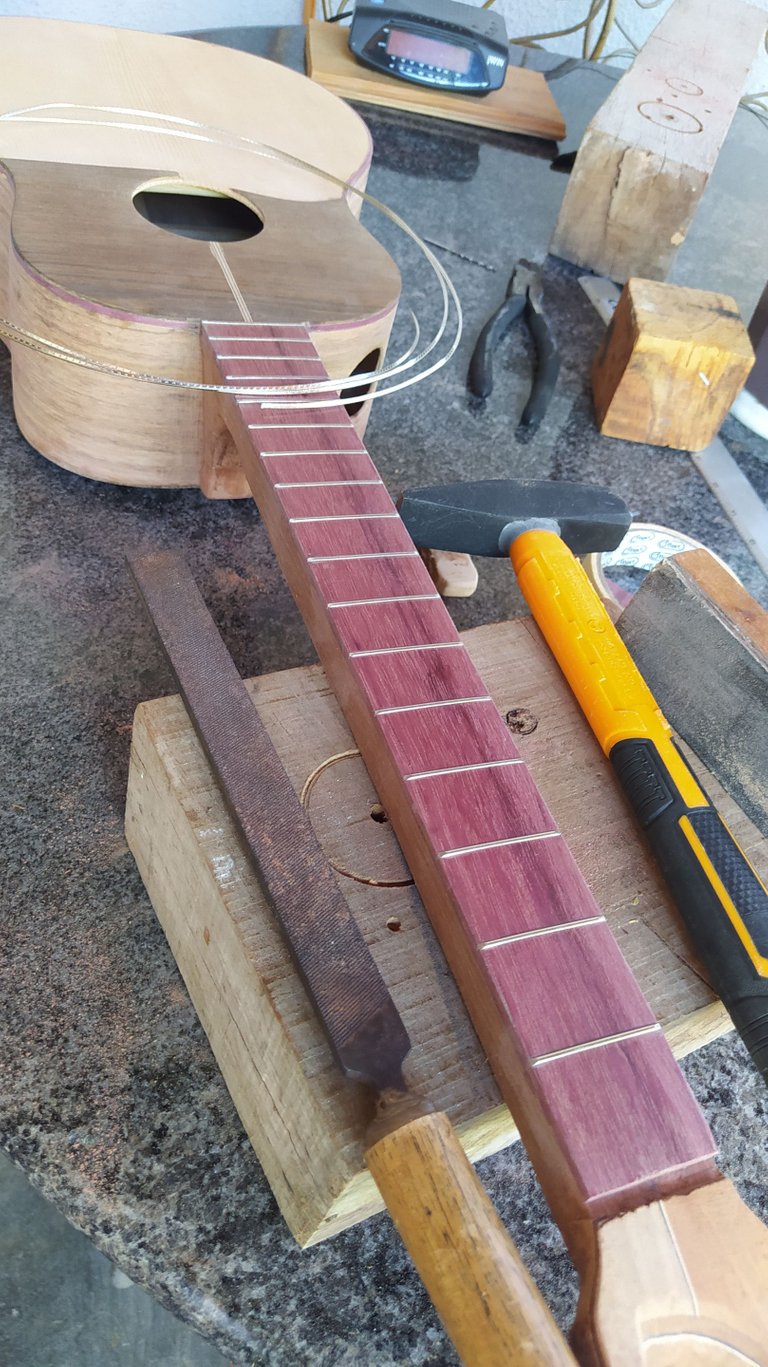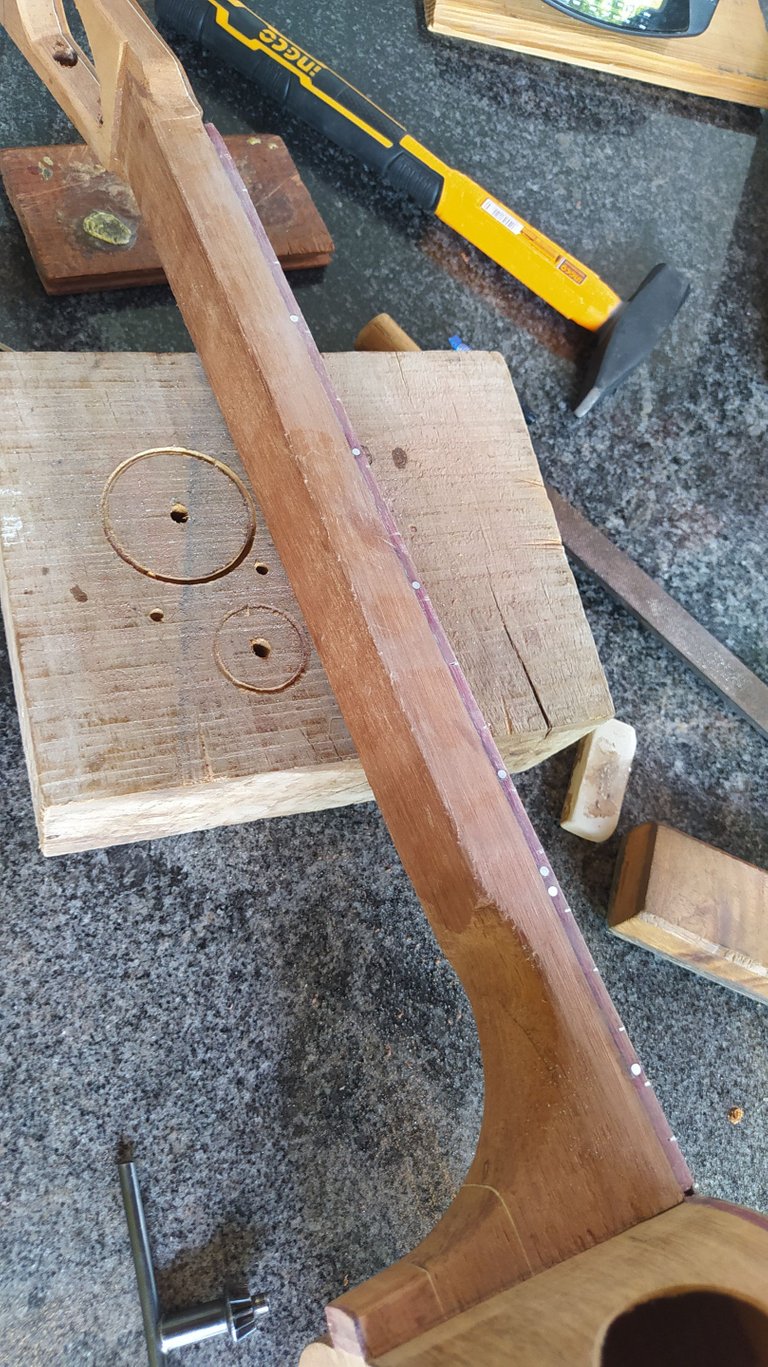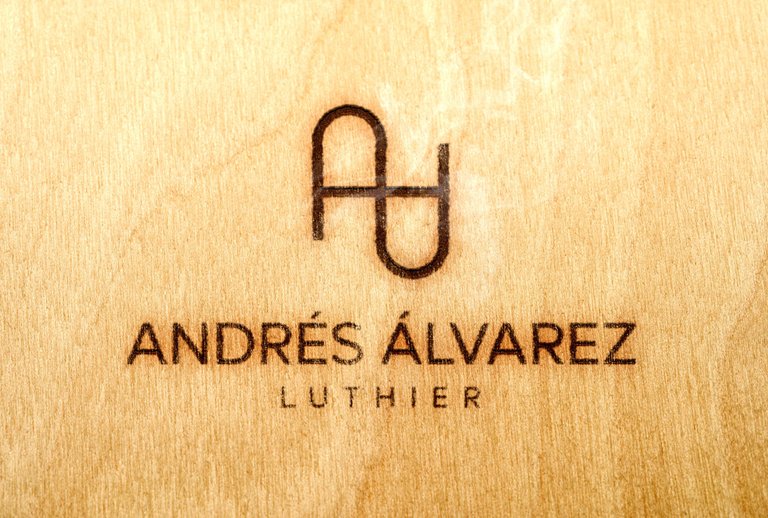

Woodworking Wednesdays are back. There's been some busy days at the workshop preparing more instruments and getting others closer to their final stage. That's always a lot of fun and it's been better to share some of that progress with you. Today, we are on for a treat. I wanted to start making some videos like some of the luthiers I admire. They are not on Hive, so it's my chance to make the breakthrough in the web 3.0. With no further a due, I'm gonna show you how I place the frets on an instrument and the position markers as well.
Volvemos a las sección de miércoles de carpintería. Han sido unos días algo atareados en el taller armando algunos instrumentos y llevando otros proyectos a sus etapas finales. Eso siempre es genial, pero es mejor cuando puedo mostrarles algo de este proceso. Hoy, tenemos una ocasión especial. Desde hace tiempo he querido hacer videos como mis luhtiers favoritos. Ellos no están en Hive así que tengo la oportunidad de ser el primero en crear este tipo de contenido en la web 3.0. Sin más preámbumos, les mostraré como coloco los trates y los puntos armónicos en uno de mis instrumentos.
Frets / Trastes

Frets are these metal pieces we find on instruments alongside the neck on the front of an instrument. They divide the fretboard into sections which are also called frets. It's kind of confusing; their function isn't. Placing your fingers in one of these sections makers the strings shorter, giving in a higher pitch sound. Thus, you can make more sounds. That's instruments' mechanics 101. Placing then is not enough. Since they are made of metal, we need to file the edges and then give then a bevel on both ends. This will prevent and cuts in the musician's fingers while they play.
Los trates son estas piezas metálicas que encontramos al frente del instrumento a lo largo del mástil. Estos dividen el diapasón en intervalos exactos. Estos espacios también se llaman trastes. Es algo confuso; su funciono no. Si colocas un dedo sobre una cuerda y pisas, te darás cuenta que ahora la cuerda es más corta y el sonido más agudo. Por lo tanto, hay más sonidos. Es un ejemplo del funcionamiento básico de un instrumento musical de cuerdas. No obstante, al estar hechos de metal hay que limarlos y biselarlos en los bordes para evitar que el músico se corte mientras toca.
In the video, you can see how I changed my approach at fret placing. Optiong yo cut the length needed instead of trying to keep the fretwire complete. It is easier that way. I guess that's why many luthiers do so.
En el video pueden observar como cambié el método para colocarlos. Cortar la cantidad de traste necesaria para cada ranura es más fácil que mantener el rollo completo. Supongo que por eso muchos luthiers lo hacen de esta manera.
Position markers / Puntos armónicos

They are optional but useful. These come in different shapes and materials. The idea behind these is to place them as marks on key frets. That way a musician has a resource to locate certain notes while playing. In the Venezuelan Cuatro, the common frets for them are the 3rd, 5th, 7th, 10th, 12th and 15th (but that also depends on the number of frets).
Estas piezas son opcionales pero muy útiles. Se pueden hacer de diversos materiales y formas. La idea es tener una marca en una posición de referencia para el músico. En el cuatro venezolano, las posiciones comunes son en los trastes 3, 5, 7, 10, 12 y 15 (aunque depende de la cantidad de trates).
To place them, I first marked the position on one side of the fretboard. Drilled a hole for each position markers (two at fret 12 since that's the mark of an octave). Then, put some cyanoacrylate in each hole and started to place this piece of aluminium, tap it with my hammer and they cut it with pliers. After each piece was in place, some filing and sanding did the work.
Para colocarlos, primero se marcó la posición a un lado del diapasón. Se hicieron agujeros para cada punto armónico (dos en el traste 12 para marcar la octava). Luego, se colocó cianoacrilato en cada agujero. Para terminar, se colocó un trozo de aluminio en cada agujero, ajustando cada uno con el martillo y cortando con pinzas. Posteriormente, se utilizó una lima y lija para terminar el trabajo.

Thumbnail made with Canva.
Photos and video taken with my Redmi note 8 smartphone.
Video editing made with Capcut.
Free copyright music.


Follow me on Instagram for enquires and commission.
If you'd like to help the workshop grow, you can make a donation here. You can find me at discord as bertrayo#1763 ▶️ 3Speak
frets look pretty difficult. I play ukulele more these days because of my kids and the size is perfect for me. I started with Acoustic guitar then moved to electric guitar and now ukulele. :)
whats the most challenging part when crafting an instrument like this one?
Everything is challenging. The frets are difficult not by virtue or getting them on, but preparing the slots. They need to be in the right spot or the tuning will off when you play.
I guess the other difficult part is selecting the wood for back, sides and sound board since that's where the whole sound of the instrument will be located. If your choice is bad, you'll a weird looking piece of furniture. 🤣
Yea I can imagine you finish up the guitar and only after playing it you realize the the notes were slightly off because of the fretboard positioning. That would be horrible!! from all that work done to it. i hope this one you are making will sound amazing. :)
This one suffered an accident and will be delayed further, but I bet it's going to sound great!
!ALIVE
!BBH
Thank you very much for these! ✨
@bertrayo! Your Content Is Awesome so I just sent 1 $BBH (Bitcoin Backed Hive) to your account on behalf of @vocup. (4/5)
@bertrayo! You Are Alive so I just staked 0.1 $ALIVE to your account on behalf of @vocup. (9/20)
The tip has been paid for by the We Are Alive Tribe through the earnings on @alive.chat, feel free to swing by our daily chat any time you want.

Thanks a lot!
The rewards earned on this comment will go directly to the people sharing the post on Twitter as long as they are registered with @poshtoken. Sign up at https://hiveposh.com.
Ser pionero en algo, siempre es importante, en algún momento se unirán más en este nicho y bueno, tu serás el maestro.
Que bueno que acompañes con un video este post y vemos como trabajas.
Muchas cosas por hacer para terminar esta pieza de la cultura venezolana.
Quizá no de una más nadie. El motivo de que yo esté haciendo esto es porque no estoy igual de ocupado que los demás. Supongo que eso es un punto a mi favor. Ya veremos si esto da frutos. Bueno, tiene rato en eso porque me ha dado los ingresos para ir armando el taller. Seguro que cuando esté abarrotado de pedidos estaré ausente de Hive por un tiempo.
Y sobre los videos, tenía rato queriendo crear está clase de contenido. Siempre lo veía por Instagram y estaba con mi "yo quiero hacer eso". Ahora lo puedo hacer y no pierdo tiempo para ponerme en eso.
Gracias por tus palabras. ✨🙏🏻
El trabajo que realiza requiere de mucha dedicación, felicidades por su obra
Muchas gracias. Es un trabajo de mucha paciencia, pero se disfruta mucho.
Thank you for sharing this amazing post on HIVE!
Your content got selected by our fellow curator @rezoanulvibes & you just received a little thank you via an upvote from our non-profit curation initiative!
You will be featured in one of our recurring curation compilations and on our pinterest boards! Both are aiming to offer you a stage to widen your audience within and outside of the DIY scene of hive.
Join the official DIYHub community on HIVE and show us more of your amazing work and feel free to connect with us and other DIYers via our discord server: https://discord.gg/mY5uCfQ !
If you want to support our goal to motivate other DIY/art/music/homesteading/... creators just delegate to us and earn 100% of your curation rewards!
Stay creative & hive on!